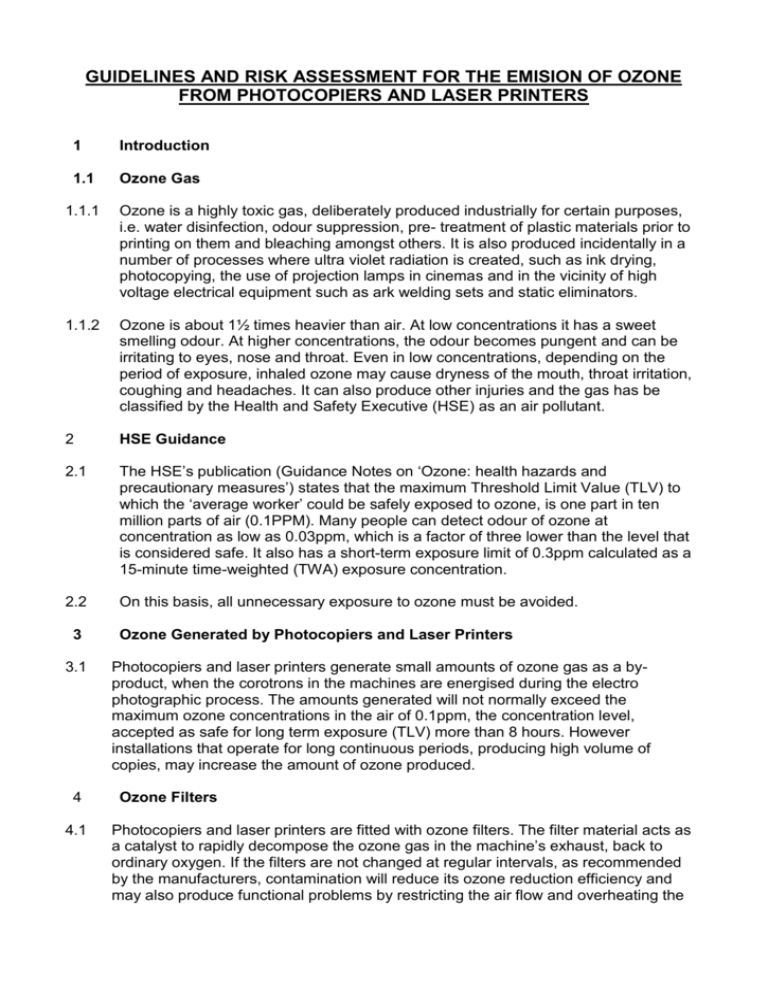emission of ozone from photocopiers and laser printers
advertisement

GUIDELINES AND RISK ASSESSMENT FOR THE EMISION OF OZONE FROM PHOTOCOPIERS AND LASER PRINTERS 1 Introduction 1.1 Ozone Gas 1.1.1 Ozone is a highly toxic gas, deliberately produced industrially for certain purposes, i.e. water disinfection, odour suppression, pre- treatment of plastic materials prior to printing on them and bleaching amongst others. It is also produced incidentally in a number of processes where ultra violet radiation is created, such as ink drying, photocopying, the use of projection lamps in cinemas and in the vicinity of high voltage electrical equipment such as ark welding sets and static eliminators. 1.1.2 Ozone is about 1½ times heavier than air. At low concentrations it has a sweet smelling odour. At higher concentrations, the odour becomes pungent and can be irritating to eyes, nose and throat. Even in low concentrations, depending on the period of exposure, inhaled ozone may cause dryness of the mouth, throat irritation, coughing and headaches. It can also produce other injuries and the gas has be classified by the Health and Safety Executive (HSE) as an air pollutant. 2 HSE Guidance 2.1 The HSE’s publication (Guidance Notes on ‘Ozone: health hazards and precautionary measures’) states that the maximum Threshold Limit Value (TLV) to which the ‘average worker’ could be safely exposed to ozone, is one part in ten million parts of air (0.1PPM). Many people can detect odour of ozone at concentration as low as 0.03ppm, which is a factor of three lower than the level that is considered safe. It also has a short-term exposure limit of 0.3ppm calculated as a 15-minute time-weighted (TWA) exposure concentration. 2.2 On this basis, all unnecessary exposure to ozone must be avoided. 3 3.1 4 4.1 Ozone Generated by Photocopiers and Laser Printers Photocopiers and laser printers generate small amounts of ozone gas as a byproduct, when the corotrons in the machines are energised during the electro photographic process. The amounts generated will not normally exceed the maximum ozone concentrations in the air of 0.1ppm, the concentration level, accepted as safe for long term exposure (TLV) more than 8 hours. However installations that operate for long continuous periods, producing high volume of copies, may increase the amount of ozone produced. Ozone Filters Photocopiers and laser printers are fitted with ozone filters. The filter material acts as a catalyst to rapidly decompose the ozone gas in the machine’s exhaust, back to ordinary oxygen. If the filters are not changed at regular intervals, as recommended by the manufacturers, contamination will reduce its ozone reduction efficiency and may also produce functional problems by restricting the air flow and overheating the internal components of the machine. (Hewlett Packard say that the filters should be changed after the equivalent of 50,000 single sided sheets have been printed). 5 Measurement of Ozone Gas 5.1 To measure the low levels of ozone gas generated will require very sophisticated instruments and highly controlled conditions and will be very expensive to undertake. Manufacturers of photocopiers and laser printers carry out regular tests on their products, for ozone emission in special ozone measurement chambers. The policy for managing the ozone product is determined from these results. It is therefore imperative that the manufacturers advise on the siting of these equipment are adhered to. 5.2 Actually, your nose is a good device for noting the presence of ozone. Remember that ozone can be smelled at concentrations much lower than the established maximum exposure limits of 0.1ppm. 5.3 If you can smell ozone for prolonged periods or at regular intervals then do something about it. 6 Siting of Photocopiers and Laser printers 6.1 Manufacturers say that Photocopiers and laser printers that operate for long continuous periods or are used for producing high volume of copies should be sited in areas that have good ventilation. They recommend that photocopiers and laser printers should be sited near windows that can be left open during the operation of these printers. If this is not possible the room should be fitted with extractors that will expell the spent air to the outside of the building. 7 Employers’ Responsibilities 7.1 Ozone is a highly toxic gas, and employers have a specific responsibility not to expose their employees to this substance and to provide a safe and healthy work environment, one that meets the HSE’s minimum safety standards. 7.2 To measure the low levels of ozone, generated by these machines, will require very sophisticated instruments and these are not suitable in work environments. It is therefore recommended that the manufacturers’ instructions are implicitly followed. 8 8.1 Manufacturers Recommendations For Minimizing Ozone Exposure Manufacturers state that almost all ozone concerns arise from abnormal sites or operating conditions. The following conditions should be avoided. Installation of multiple copiers and printers in a confined area. Extremely low relatively humidity. Poor room ventilation. (Ensure that there are at least 4 changes of room air is provided hourly). The exhaust port of the printer is directly towards the face of personnel. Not changing filters as required by the manufacturers. Long, continuous printing. 9 Further Advice 9.1 If you require further advice please contact the manufacturers of the printers or the Education Safety Officer.






